Comparing Two 1TB NVMe Drives with Same NAND, Same Controller: XPG SX8200 Pro vs HP EX950
by Billy Tallis on February 6, 2019 11:30 AM ESTAnandTech Storage Bench - Light
Our Light storage test has relatively more sequential accesses and lower queue depths than The Destroyer or the Heavy test, and it's by far the shortest test overall. It's based largely on applications that aren't highly dependent on storage performance, so this is a test more of application launch times and file load times. This test can be seen as the sum of all the little delays in daily usage, but with the idle times trimmed to 25ms it takes less than half an hour to run. Details of the Light test can be found here. As with the ATSB Heavy test, this test is run with the drive both freshly erased and empty, and after filling the drive with sequential writes.
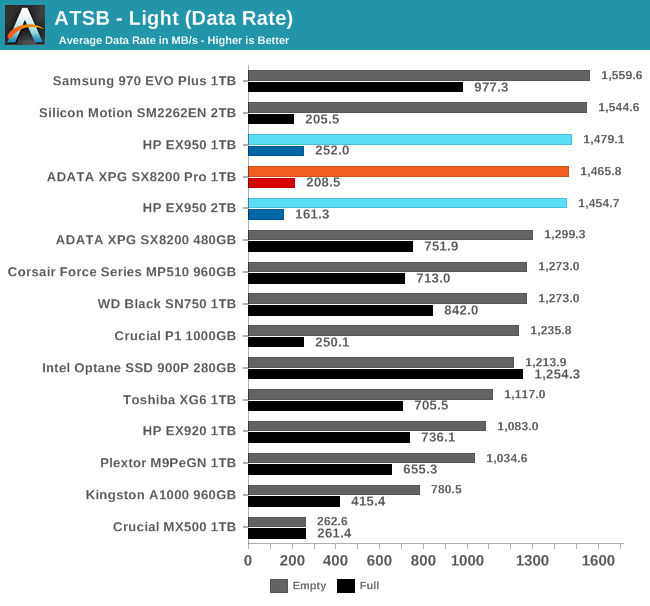
When the Light test is run on an empty drive, the SM2262EN SSDs offer excellent performance, but it's not meaningfully better than what last year's models did with the original SM2262 controller. What's changed is that full-drive performance is much worse, and the gap between empty and full drive performance is much larger for the Light test than for the Heavy test.
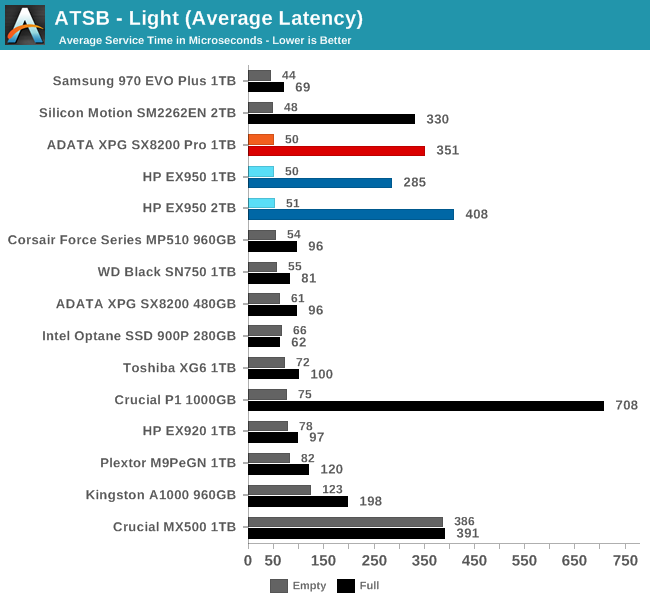
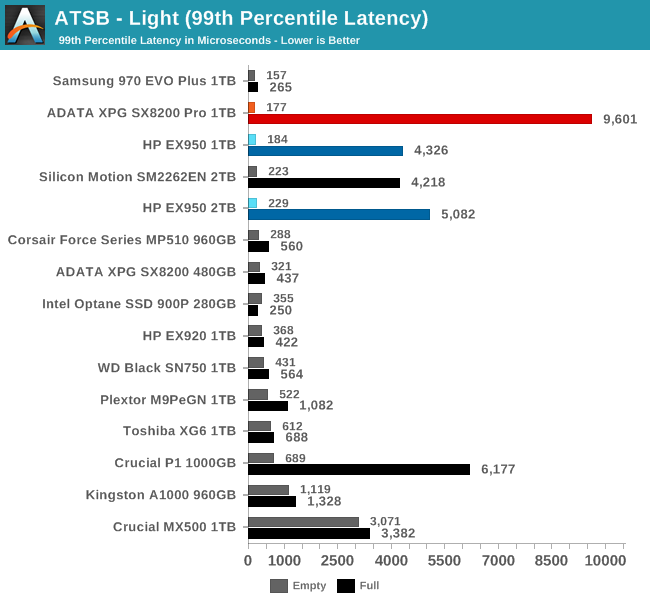
The average and 99th percentile latency scores for the SM2262EN drives are barely slower than the Samsung 970 EVO Plus when the Light test is run on an empty drive, but the full-drive average latency is about as bad as a mainstream SATA drive, and the 99th percentile latencies are worse.
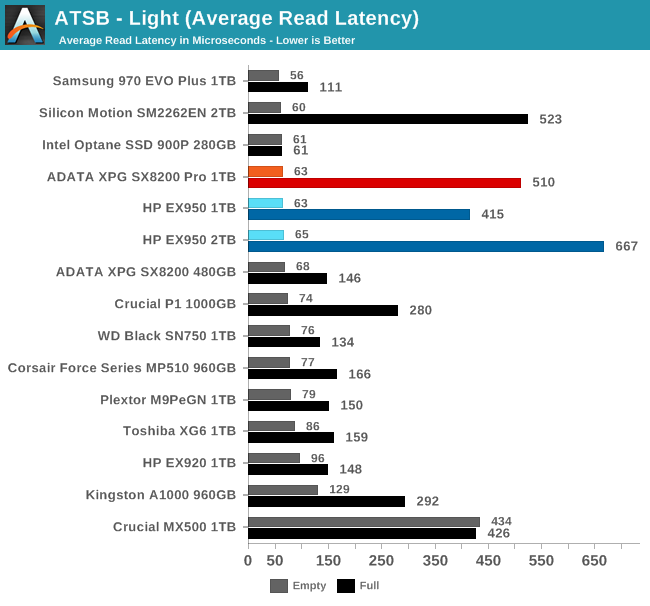
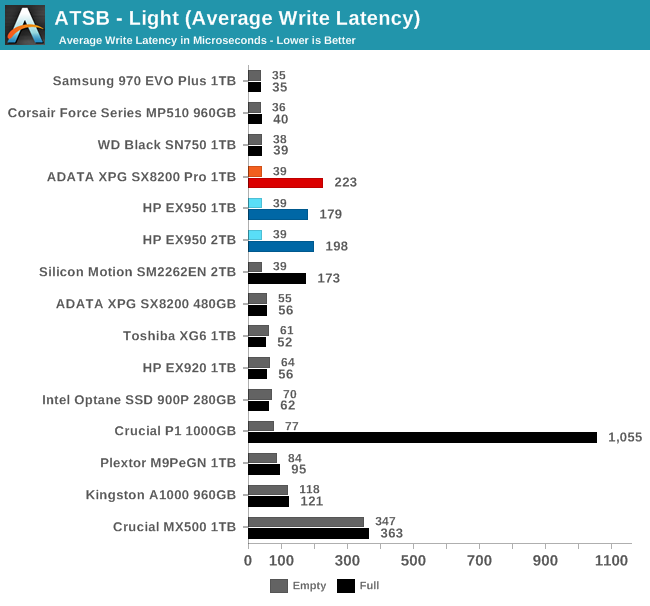
The average read and write latency scores for the SM2262EN drives are within a few microseconds of the fastest drives when the Light test is run on an empty drive, but when the drives are full the read latency ends up in SATA territory and the write latency comes close to that.
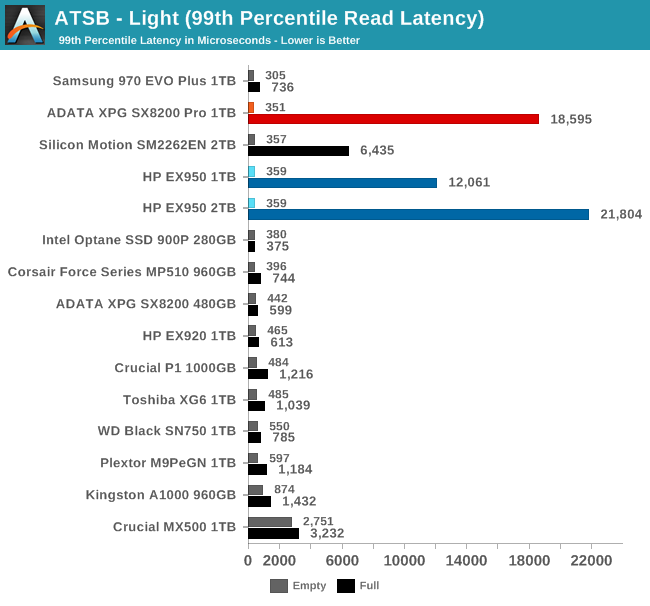
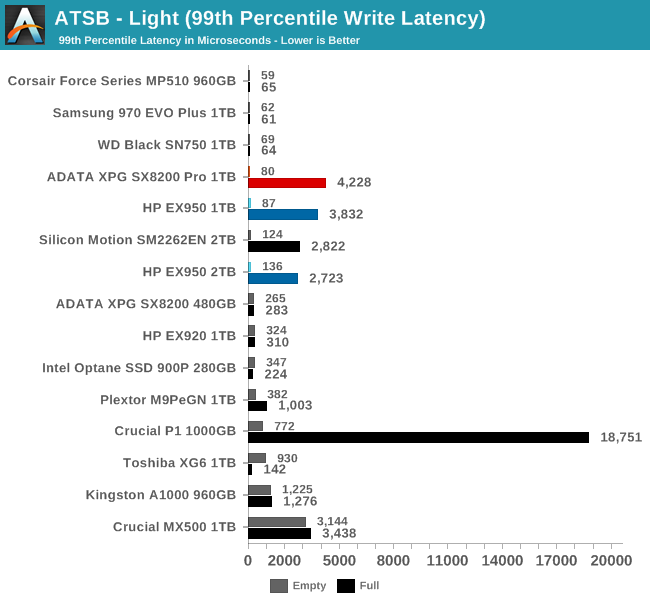
The 99th percentile read and write latency scores again show no problem for the SM2262EN drives when the Light test is run on an empty drive, but the full-drive performance is a problem. In this case, the 99th percentile read latency is especially bad, with the retail SM2262EN drives scoring worse than the engineering sample and providing tail latencies several times higher than the Crucial MX500 SATA drive.
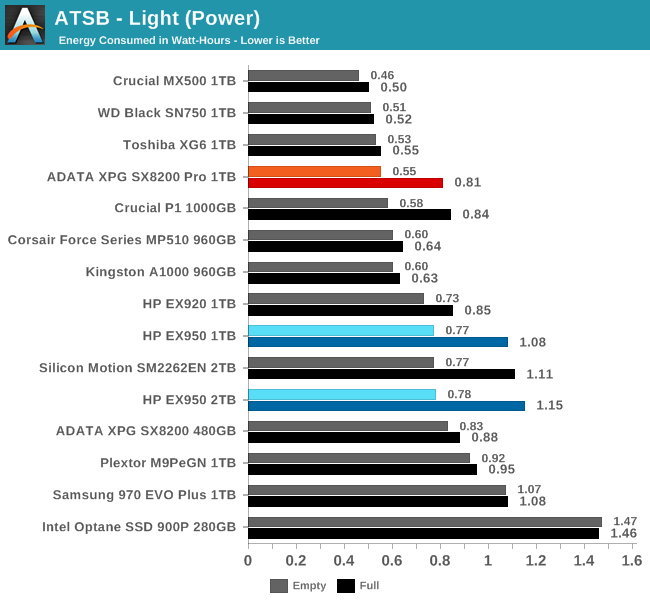
The SM2262EN drives again show significantly higher energy requirements when the test is run on a full drive rather than an empty drive. The ADATA SXP SX8200 Pro's efficiency advantage over the HP EX950 means the former's efficiency is still decent by NVMe standards even for the full-drive test run.










42 Comments
View All Comments
wolfesteinabhi - Wednesday, February 6, 2019 - link
this is a bit of worrying trend where we are getting same products with new/updated firmware...the firmware that was essentially free earlier...and get improved performance...now they have to pay and buy new hardware for it.ERJ - Wednesday, February 6, 2019 - link
When is the last time you updated the firmware on your hard drive? RAID card / BIOS / Video Card sure, but hard drive?Now, you could argue that the controller is essentially part of the hard drive in this case but still.
jeremyshaw - Wednesday, February 6, 2019 - link
Hard drive? They aren't that old, right? You do remember HDD firmware updates. As for SSDs, I've recently updated the firmware on my SSDs. Heck, even my monitor has been through a firmware update. Like the SSD updates, the monitor firmware affected performance and compatibility.jabber - Thursday, February 7, 2019 - link
I used to worry about SSD firmware updates when I was getting in 1 every blue moon and it had novelty value but 200+ SSDs later I now just don't bother. At the end of the day getting an extra 30MBps just isnt the boost it was all those years ago.ridic987 - Wednesday, February 6, 2019 - link
We are discussing SSD's not hard drive. Literally the thing what he is saying most applies to.Samus - Thursday, February 7, 2019 - link
I agree, the lack of SSD firmware updates - particularly what WD has pulled with the Black SSD's - is troubling. To artificially limit product improvement through restricting software updates and requiring the user to purchase an entirely new product sets a bad precedent. They could at least do what HP does in the server market and charge for support beyond the warranty. After a server warranty is up (typically 3 years) you have to pay for firmware and BIOS updates for servers. This isn't a terrible policy, at least it wasn't until meltdown\spectre hit and all the sudden it seemed somewhat necessary to update server firmware that were many years old.Hard drives get firmware updates all the time - just not from the manufacturers. They typically applicable to retail products for reasons. But go ahead and look up a random OEM PC's drivers from Dell or HP and you might see various firmware updates available for the hard disk models those PC's shipped with.
Are they important though? Rarely. Barring any significant bug, hard disks have little to benefit from firmware updates as they are so mechanically limited and the controllers are generally quite mature, having been based on incremental generations of past firmware. This could all change as MAMR and HAMR become more mainstream, the same way the only hard disk firmware I remember being common were the WD Black2 (the SSD+HDD hybrid) and various Seagate SSHD's - for obvious reasons. The technology was new, and there are benefits to updating the SSD firmware as improvements are made through testing and customer feedback.
melgross - Thursday, February 7, 2019 - link
I think of it the other way around. Unless there’s a serious bug in the firmware, firmware upgrades are a gift, that manufacturers don’t have to give.The fact is that even when they are available, almost no one applies them. That’s true even for most who know they’re available. It’s alwasys dangerous to upgrade firmware on a product so central to needs. If there’s an unfounded bug in the new upgrade, that could be worse than firmware that’s already working just fine, but isn’t quite as fast as you might wish foe.
I’ve never seen any major upgrade in performance from a drive firmware upgrade. Ever.
FullmetalTitan - Thursday, February 7, 2019 - link
Those of us around for sandforce controllers remember well the pains of updating SSD firmware to make our drives useableDigitalFreak - Wednesday, February 6, 2019 - link
Billy - how far are we away from having 4TB M.2 NVMe drives?Billy Tallis - Wednesday, February 6, 2019 - link
Most SSD vendors could produce 4TB double-sided M.2 drives using off the shelf parts. Putting 4TB on a single-sided module would require either going with a DRAMless controller, stacking DRAM and the controller on the same package, or using 1Tb+ QLC dies instead of TLC.So currently any 4TB M.2 drive would have at least some significant downside that either compromises performance, restricts compatibility, or drives the price up well beyond twice that of a 2TB M.2 drive. There's simply not enough demand for such drives, and likely won't be anytime soon.